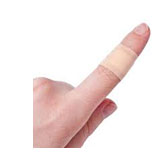 | Page 19 of 25 |  |
CUTS AND SCRAPES

There are three general steps to treat a cut or scrape.
• Stop the bleeding.
• Clean the wound.
• Cover the wound.
Minor cuts and scrapes usually stop bleeding on their own. If they don't, apply gentle pressure with a clean cloth or bandage. Hold the pressure continuously for 20 to 30 minutes. Don't keep checking to see if the bleeding has stopped because this may damage or dislodge the fresh clot that's forming and cause bleeding to resume. If the blood spurts or continues to flow after continuous pressure, seek medical assistance.
Rinse out the wound with clean water. Soap can irritate the wound, so try to keep it out of the actual wound. If dirt or debris remains in the wound after washing, use santized tweezers to remove the particles. If debris remains embedded in the wound after cleaning, see a doctor. Thorough cleaning reduces the risk of tetanus. After cleaning the wound, apply a thin layer of an antibiotic cream or ointment to help keep the surface moist.
Cover the wound with a bandage. Bandages can help keep the wound clean and keep harmful bacteria out. After the wound has healed enough to make infection unlikely, exposure to the air will speed wound healing. Change the dressing at least daily or whenever it becomes wet or dirty.
A wound that cuts deeply through the skin or is gaping or jagged-edged and has fat or muscle protruding usually requires stitches. A strip or two of surgical tape may hold a minor cut together, but if you can't easily close the wound, see a doctor as soon as possible. Proper closure within a few hours minimizes the risk of infection.
Watch for signs of infection. See a doctor if the wound isn't healing or you notice any redness, drainage, warmth or swelling.
 | Page 19 of 25 |  |




